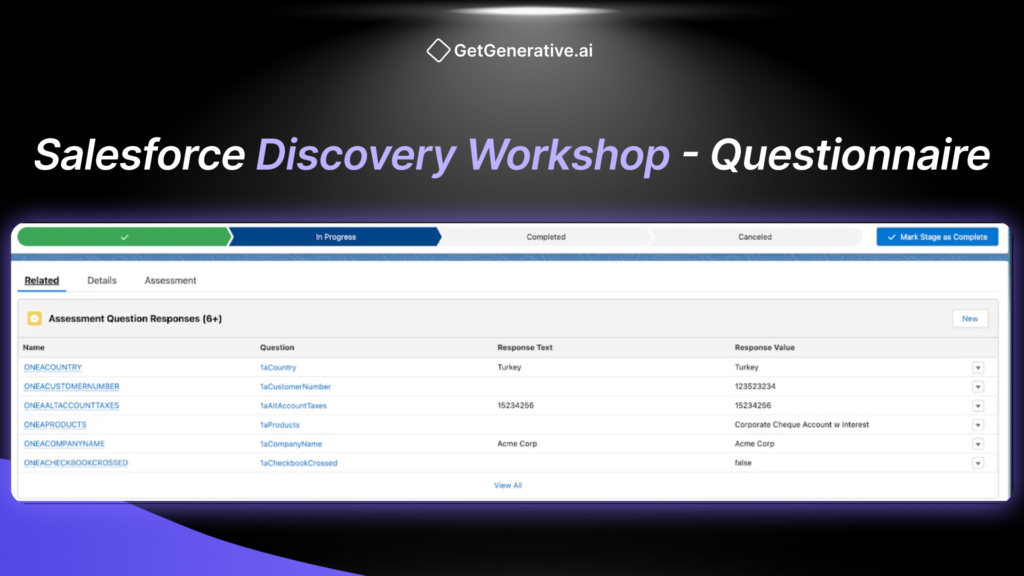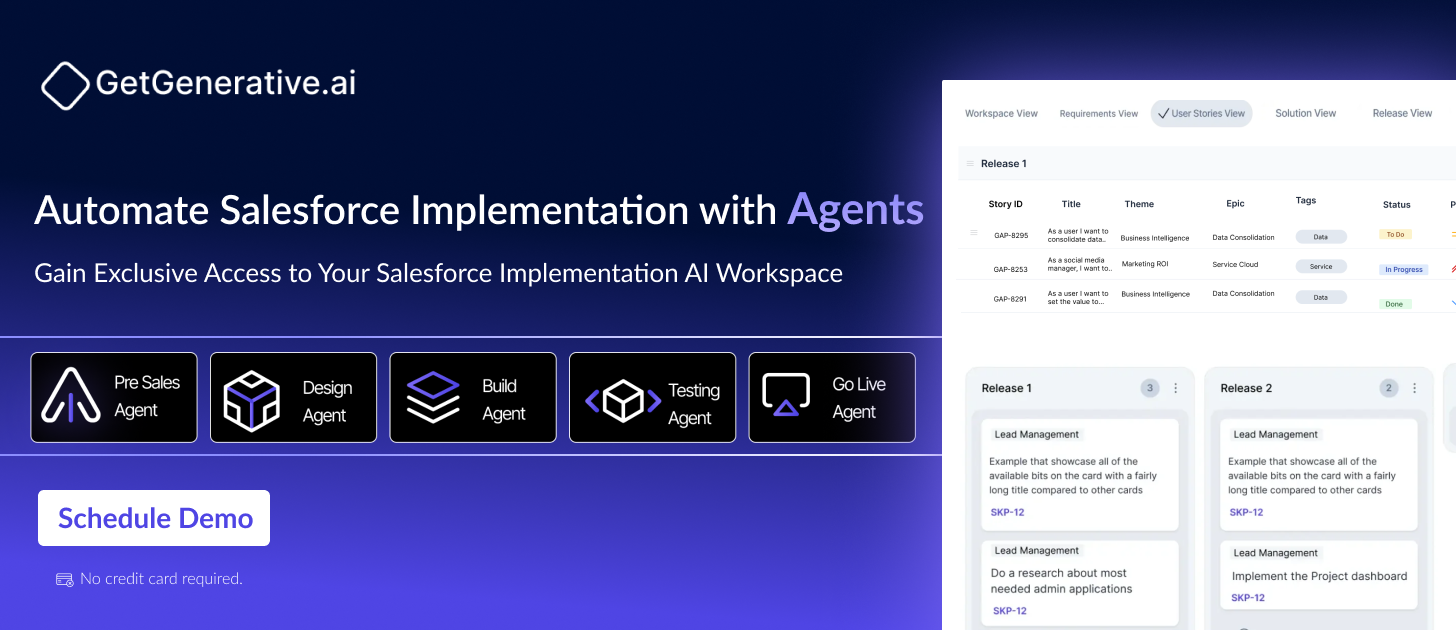Salesforce Discovery Workshop – Questionnaire
Start With the ‘Why’
Before any lines of code are written or custom fields are configured, one phase sets the foundation for everything that follows – the discovery workshop. It’s where clarity begins, assumptions are tested, and true alignment is built. But what makes or breaks a successful discovery session? The right questions.
This workshop isn’t just a checklist; it’s a collaborative deep dive. Done right, it uncovers critical business insights and prevents missteps down the line. It’s like building a blueprint before constructing a skyscraper—skip it, and everything wobbles later.
Why the Discovery Phase Matters
Avoiding Misaligned Solutions
Without clear requirements and shared understanding, your Salesforce implementation can veer off course. A robust discovery session prevents this by mapping out what success looks like—and how to get there.
Turning Goals Into Measurable Outcomes
The real magic lies in turning vague objectives like “We want better reporting” into SMART goals: Specific, Measurable, Achievable, Relevant, and Time-bound. Instead of “better,” you get “30% faster case resolution within six months.”
Capturing the Full Picture
Discovery isn’t just about technology—it’s about people, processes, and challenges. It helps you ask:
- What systems are in play?
- Where are the inefficiencies?
- Who’s struggling—and why?
These insights set the stage for smarter solution design.
“Artificial intelligence and generative AI may be the most important technology of any lifetime.”
- Marc Benioff, Chair, CEO, and Co-founder of Salesforce
Key Objectives of the Discovery Workshop
Here’s what a strong discovery workshop should deliver:
- Define the Vision and Success Criteria: Align on what success means. Higher NPS scores? Better lead conversion? Faster service turnaround? Nail it down early.
- Understand the Current State and Pain Points: Map how the business works today—including the pain it’s feeling.
- Clarify Requirements and Scope: Separate what’s needed now from what’s “nice-to-have later.” Prioritize ruthlessly.
- Build Stakeholder Alignment: Get everyone from sales to IT on the same page. No surprises later.
- Identify Constraints and Risks: Uncover data issues, integration dependencies, and budget limits before they derail the project.
Also Read – Salesforce Implementation Presales & Project Scoping
The Top-Down Approach: How to Structure Discovery Conversations
Start high-level. Work your way down. Here’s the proven sequence:
- Why – Why are we doing this? What’s the business goal?
- Who – Who’s involved? What roles and departments?
- How – How do current processes function?
- What – What are the exact system requirements?
This layered method helps ensure every question links back to a business outcome—not just a feature wishlist.
Salesforce Discovery Questionnaire: Key Categories to Cover
Let’s explore the essential categories to shape your discovery questionnaire.
1. Business Objectives and Success Metrics
This is your north star. Ask:
- “What are the main business goals driving this Salesforce project?”
- “What does success look like in measurable terms?”
- “Are there deadlines or external pressures we should be aware of?”
Aligning on goals ensures every requirement supports the bigger picture. It also builds buy-in—when people see their objectives shaping the project, they get engaged.
2. Current Systems and Technology Landscape
This is where the tech talk begins. Ask:
- “Which systems do you use for sales, support, marketing?”
- “Which systems will stay, and which will Salesforce replace?”
- “Do these tools talk to each other—or operate in silos?”
Integration requirements, legacy dependencies, and existing data challenges all come to light here. A common scenario? Data living in five places—none of them connected.
3. Data Management and Migration
No Salesforce project succeeds without clean, reliable data. Ask:
- “What data needs to be migrated, and from where?”
- “How accurate is your current data?”
- “Who owns and maintains your data today?”
Poor data quality is a top reason CRM projects fail. Use discovery to flag risks and plan clean-up or consolidation strategies.
4. Sales Processes and Pipeline Management
Even if Sales Cloud isn’t the primary focus, sales workflows often intersect with other functions. Ask:
- “Can you walk us through a typical lead-to-close journey?”
- “What sales roles exist, and how do they collaborate?”
- “Where do deals get stuck or delayed?”
Understanding the sales lifecycle informs lead routing, opportunity stages, and automation rules. And if CPQ or e-signatures are part of the process, you’ll uncover that here.
5. Customer Service and Support Workflows
Whether it’s via email, phone, or chat, support is often where the customer experience is won—or lost. Ask:
- “How are support cases created, managed, and escalated?”
- “What support channels do you offer?”
- “Do you track SLAs or customer satisfaction?”
This reveals requirements for Service Cloud features like queues, macros, omnichannel routing, and knowledge articles.
Also Read – Salesforce Implementation Proposal Checklist
6. Reporting and Analytics Requirements
If you can’t measure it, you can’t manage it. Ask:
- “What key metrics do leaders need to see?”
- “What reports and dashboards are you currently using?”
- “Are there reports that are difficult or time-consuming to generate?”
Salesforce is a goldmine for data—but only if it’s set up to capture and surface the right insights. Discovery ensures reporting isn’t an afterthought but a core part of the build.
7. User Adoption and Training Considerations
A brilliant system means nothing if no one uses it. Ask:
- “Who will be using Salesforce, and how many users are there?”
- “What’s their experience with CRMs?”
- “What kind of training or support will they need?”
Discovery isn’t just about the platform—it’s about people. Understanding comfort levels and resistance points allows you to plan training, change management, and support accordingly.
8. Integration Points and External Interfaces
Salesforce rarely works alone. Ask:
- “What other systems does Salesforce need to integrate with?”
- “What data should flow in or out—and how often?”
- “Are there any APIs, middleware tools, or custom connectors already in use?”
Integration complexity often gets underestimated. Discovery should identify all the systems Salesforce needs to “talk to” and whether that’s real-time or batch. Planning this early avoids last-minute scrambles.
9. Compliance and Security Requirements
Especially for regulated industries, this is non-negotiable. Ask:
- “Are there any regulatory standards we must follow (e.g. GDPR, HIPAA)?”
- “Does certain data need to be encrypted, masked, or retained for a set period?”
- “What user access policies or audit tracking is required?”
Security and compliance need to be baked into the system design—not bolted on later. This part of discovery helps avoid costly rework or even legal risks.
10. Organizational Constraints and Risks
No project exists in a vacuum. Ask:
- “Are there any time, budget, or resource constraints we should know about?”
- “Will any key stakeholders be unavailable during the project?”
- “Are there cultural or organizational hurdles that might impact rollout?”
Surfacing risks early allows the team to plan mitigations. For example, if a critical SME is on vacation during UAT, you can adjust timelines now—not scramble later.
“There’s no question we are in an AI and data revolution, which means that we’re in a customer revolution and a business revolution.”
- Clara Shih, Head of Business AI at Meta
Best Practices for Running a Discovery Workshop
Keep It Conversational, Not Interrogational
Your goal isn’t to read off a script—it’s to spark insights. Use questions to guide a story, not just check a box.
Document, Prioritize, and Confirm
Capture answers thoroughly, organize them into categories, and—most importantly—review them with the client. Discovery isn’t complete until everyone says, “Yes, that’s what we need.”
Visualize When Possible
Use flowcharts, process maps, and mock dashboards to clarify discussions. Many stakeholders understand pictures better than paragraphs.
Deliverables to Expect Post-Discovery
At the end of a thorough discovery process, you should have:
- A clear vision statement and success criteria
- A well-documented list of functional and non-functional requirements
- An inventory of current systems, processes, and integration points
- A gap analysis between current state and future state
- A set of user stories or use cases for design and implementation
- An initial risk and constraints log
- Draft reporting/dashboard needs
- A plan for data migration and user adoption
These aren’t just “nice to have”—they’re your playbook for execution.
Also Read – Salesforce Proposal Creation with AI Agents
End Note: Ask More, Guess Less
A Salesforce Discovery Workshop isn’t about guessing what a business needs—it’s about asking the right questions to find out. When done right, discovery ensures that every field, flow, and dashboard serves a real purpose. It aligns teams, eliminates surprises, and turns Salesforce into a solution that truly works.
With GetGenerative.ai, you can create, refine, and manage discovery questions in minutes using AI-powered agents – from Pre-Sales to Go-live.
Let our intelligent agents handle the heavy lifting so your team can focus on what truly matters: delivering value.
Start your AI-driven discovery today at GetGenerative.ai
FAQs
1. How long should a Salesforce discovery workshop last?
Depending on complexity, a workshop can run from 2 hours to several full-day sessions. For enterprise implementations, multiple sessions across departments are common.
2. Who should attend the discovery workshop?
Key stakeholders from all relevant functions—sales, service, marketing, IT, and operations—should participate. Decision-makers and power users are especially critical.
3. What format should the discovery questionnaire take?
Use a structured, categorized template in Google Docs, Sheets, or your CRM notes tool. Tailor it per industry or department. Keep it collaborative and editable.
4. What happens if something is missed during discovery?
Missed requirements can lead to change requests, scope creep, or poor user adoption later. That’s why thoroughness and validation with stakeholders are essential.
5. Is the discovery workshop only for new implementations?
Nope! It’s equally valuable for optimization, re-implementation, or merging systems post-acquisition. Anytime you want to improve how Salesforce supports the business, start with discovery.




